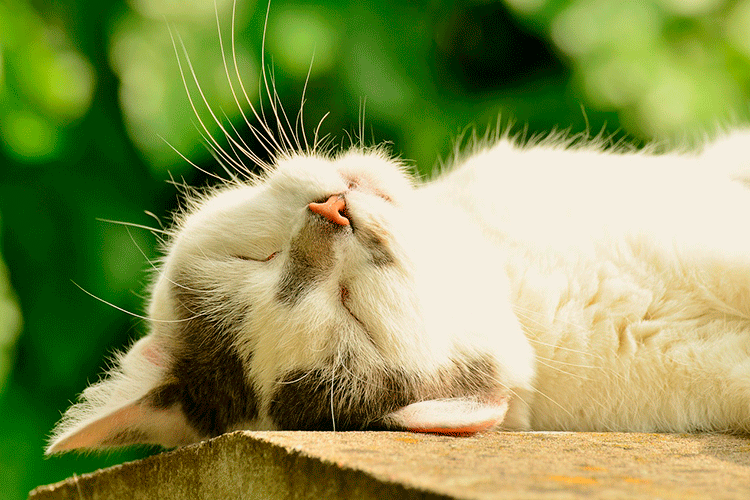![]()
Like humans, cats can get ear problems which are extremely irritating and painful and should be diagnosed and treated right away. By providing routine care of your feline’s ears and managing the underlying issue, you can help prevent the problem from returning. If your cat has parasites, allergies, or a weak immune system, they are more susceptible to ear infections. But how do you know if your cat has an ear problem?
What should your Cat’s Outer Ear look like?
A healthy outer ear or pinna should have a layer of hair on the surface with no bald spots, and should be clean and light pink in colour. Any discharge, redness, or swelling indicates you should get your cat checked.
How to Examine Your Cat’s Ears
Take your cat into a quiet room, with no other pets or people around. Gently fold back the outer ear and peek into the ear canal. If healthy, it will be pale pink in colour, and have no odour, debris, and little to no wax. Do this for each of your cat’s ears on a regular basis to make sure they are healthy and there’s no build up of wax or debris. If you find any dark coloured debris, excessive wax, or your cat’s ear has a bad odour, you need to see your veterinarian who may refer you to the vet dermatologist depending on the condition.
Is it Okay to Clean My Cat’s Ears?
Vet-supervised cleaning in case of a medical problem is recommended over routine ear cleaning yourself, as often increased ear wax or discomfort is usually accompanied by an underlying cause of the ear problems. Monitoring, as we described above, is adequate enough.
Like humans, it’s best not to go digging into the ear canal (no q-tips!) as it can not only cause extreme discomfort and trauma to the ear drum but also lead to further complications.
Signs You Should Get Your Cat’s Ears Checked
- Relentless scratching and pawing at the ears and surrounding areas
- The ears are sensitive to the touch
- Head tilt
- Frequent head shaking
- Your cat seems off balance and disoriented
- There is redness and swelling of the outer ear and/or ear canal
- Bad odour
- Black or yellowish discharge, or an accumulation of dark brown wax
- Hearing loss
- Bleeding in the ears
- Changes in behaviour such as depression or irritability
Possible Ear Disorders
- Ear Mites (Otodectes cyanotis)—parasites that are contagious among pets (i.e. a dog can pass it along to a cat). Signs include excessive itching of the ears and debris that resembles coffee grounds.
- Ear Canal Infections—usually caused by bacteria or yeast. There’s almost always an underlying cause leading to these infections. Signs are increased ear scratching, head shaking, a bad odour from the ears, and increased ear wax.
- Middle Ear Infections—with long term infections (no matter the cause) bacteria can move past the ear drum and into the middle ear. Specialized procedures and equipment may be needed for treatment of middle ear infections. Sedation may be needed. Ear drops are usually not adequate enough for treatment. This kind of infection can cause head tilt, pain while trying to eat, lethargy, and irritability.
- Ear (Aural) Hematoma—blood and serum can form between the cartilage and skin of the outer ear. This can be caused by and can occur in association with allergies, infection, ear mites, fleas, or trapped debris.
- Rupture of the ear drum (tympanic membrane).
- Ear masses, including inflammatory polyps.
Diagnosis and Treatments
How Your Cat is Diagnosed
The veterinary dermatologist will discuss your cat’s history in full detail. It is important in determining if there is an underlying disease that may be the cause. A complete physical will be performed. Using video-otoscopy the vet dermatologist can look down the ear canal for issues such as redness and inflammation, discharge, masses and polyps, foreign bodies, and other abnormalities. If discharge is uncovered inside the ear canal, deep cleaning and flushing the ear canal with irrigation will help to better assess the ear drum.
Depending on what is found, other testing or procedures may be required for further diagnosis. A microscopic examination of the ear canal may need to be done in order to diagnose or rule out infections either bacterial or fungal (yeast). Ear culture may also be needed but only in certain cases.
What are some Treatment Options?
Once properly diagnosed by your veterinarian, possible treatments can include ear drops, deep ear cleaning, anti-inflammatory medication, and treatment for the underlying cause that led to ear problems in your cat.
Creative Commons Attribution: Permission is granted to repost this article in its entirety with credit to VetDERM Clinic and a clickable link back to this page.

Dr. Jangi Bajwa is a Board certified veterinary dermatologist at VetDERM Clinic in Surrey BC. He is also the dermatology feature editor for Canadian Veterinary Journal. Dr. Bajwa’s special interests include otitis and allergic disease in pets; as well as helping improve quality of life of pets and their families.



 by
by